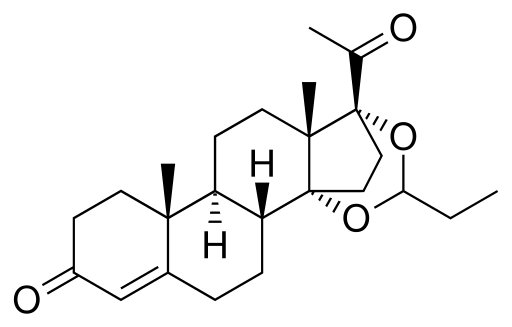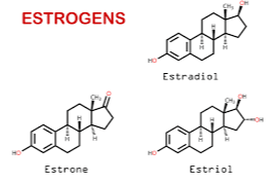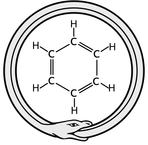A SHORT PRIMER ON HISTORY OF H.R.T. AND BALANCING FEMALE HORMONES

“The fundamental question we must confront is: why, for four decades, since the mid-1960s, were millions of women prescribed powerful pharmacological agents already shown, three decades earlier, to be carcinogenic?” From the study discussed directly below
I well remember when the SHTF concerning HRT (Hormone Replacement Therapy). It was 2002, and the massive WHI study (Women’s Health Initiative) had reached conclusions that were 180 degrees opposite of what women (not to mention their doctors) had been told for the better part of four decades — that HRT was not only safe, but could actually help prevent a bevy of female diseases and health issues.
Shortly after, a massive response to this study by over twenty elite researchers and physicians was published in one of the many journals put out by BMJ — the Journal of Epidemiology & Community Health (Hormone Replacement Therapy, Cancer, Controversies, and Women’s Health: Historical, Epidemiological, Biological, Clinical, and Advocacy Perspectives). Pay attention as these authors release a firestorm.
“Routine acceptance of use of HRT was shattered in 2002 when results of the largest randomised clinical trial of HRT, the women’s health initiative, conducted in a population of mainly healthy women, indicated that long term use of the combined estrogen plus progestin not only was associated with increased risk of breast and ovarian cancer but, contrary to expectations, did not decrease, and may in fact have increased, risk of cardiovascular disease. Similar results were reported in 1998 by the smaller heart and estrogen/progestin replacement study (HERS), conducted among women with a history of cardiovascular disease.
Together, these findings were treated as unexpected in both the scientific literature and popular media, given nearly four decades’ worth of recommendations, based on clinical experience, laboratory research, and observational epidemiological studies, for using HRT to stave off ill effects of aging and to prevent cardiovascular disease.”
What was the Women’s Health Initiative and should the results have been “unexpected“? The NIH (National Institutes of Health) started following 162,000 post-menopausal American women back in the early 1990’s, looking at HRT as it specifically related to HEART DISEASE, CANCER, and OSTEOPOROSIS (in this case, the authors were trying to determine the magnitude of benefit or HRT for slowing down said diseases).
What was not surprising is that the study found no benefit of CALCIUM PLUS VIT D for preventing fractures. Nor did they find any sort of RELATIONSHIP BETWEEN DIET AND CANCER. What they did find, however, was that HRT did not perform as universally touted. Our nation’s highest pinnacle of truth and firmest pillar of exactitude (Wikipedia) put it this way.
“The HRT component had originally been designed to include a follow-up period of nine years. However, interim monitoring of the combined estrogen/progestin treatment group indicated an increased risk of breast cancer, coronary heart disease, stroke, and pulmonary embolism, which outweighed the evidence indicating a benefit in preventing colorectal cancer and fractures. As a consequence, the study was stopped in July 2002, with an average follow-up period of 5.2 years.
The unopposed estrogen trial was halted in February 2004, after an average follow-up period of 6.8 years, on the basis that unopposed estrogen did not appear to affect the risk of heart disease, the primary outcome, which was in contrast to the findings of previous observational studies. On the other hand, there were indications for an increased risk of stroke. As a consequence of the findings, which indicated that the incurred risks of HRT outweigh the identified benefits, the study authors recommended that HRT not be prescribed for the purpose of chronic disease prevention in postmenopausal women.”
Gulp! How many times have you heard of a study this huge being halted midstream because the authors realized just how dangerous the thing(s) being studied (MEDICAL PROCEDURES / DRUGS) really are? That, folks, is exactly what happened here. But it’s not like these findings were really new a decade and a half ago in 2002, even though most “experts” were walking around in a daze as though it were.
In the section labeled “History” in the BMJ study, the authors addressed the fact that we’ve known about the many problems associated with HRT since the 1930’s — not much different, really, than the amazing work of DR. OTTO WARBURG that both the practicing and scientific medical communities continue to ignore en masse.
For instance, these authors revealed of the first wave of HRT biomedical research decades earlier that, “in the 1930s, once laboratory techniques succeeded in making estrogens available as a manufactured drug…. biochemists and endocrinologists conducted animal experiments that provided evidence of the carcinogenicity of sex hormones. For clinicians, these studies translated to debates about the correct dose to be given, as hormones were viewed as ‘natural’ and thus not intrinsically harmful.”
The second wave of HRT research started in the 1960’s, mostly as a result of widespread use of “The Pill”. The FDA had approved the drug Enovid for contraceptive use by women in 1960, which is a large part of what led to Robert Wilson’s famous book. Here are some cherry-picked sentences from Forever Health dot com (A Brief History of Hormone Replacement Therapy).
“In 1966, Robert A. Wilson, M.D.’s book, Feminine Forever, informed women that ‘menopause is completely preventable’ and advised them to take estrogen. The promise of remaining ‘feminine forever’ was met with enthusiasm, and synthetic estrogen became the standard therapy for women undergoing ‘the change’. When it later became obvious that estrogen encourages the growth of the uterine lining, which could increase the risk of cancer, the medical community suggested progesterone to protect the uterus.
But rather than combine bioidentical progesterone with estrogen, pharmaceutical companies added progestin, a synthetic form of progesterone that was patentable. As a result, Prempro was born. It combined synthetic progesterone (progestin) with Premarin, a drug composed of three estrogens (estrone, equilin, and equilenin) that are derived from horse urine [Premarin = pregnant mare’s urine]. While the drugs relieved menopausal symptoms for millions of women, the long-term effects were unknown.”
This last sentence is true of most drugs (actually it’s not completely true of most drugs — we already know that long-term use of most drugs takes you to bad places — HERE). You’ll never hear me argue the fact that drugs (at least many drugs) don’t do what they are supposed to do as far as relieving symptoms is concerned. For instance, CORTICO-STEROIDS are almost miraculous in their ability to relieve pain and the effects of unbridled INFLAMMATION.
However, click the provided links and you’ll see just how scary these drugs really are over the long haul (not to mention the fact that the relief is usually extremely short-lived). We see the same thing for the rest of THE BIG FIVE as well as HEARTBURN MEDICATIONS, ANTIDEPRESSANTS, OSTEOPOROSIS DRUGS, DIABETES MEDS, etc, etc, etc, etc. And we’ve seen it with HRT. What did BIG PHARMA do about the situation? Believe me when I tell you that they did not go down without a fight.
Shortly after making the statement, “Only a small fraction of the roughly 100,000 chemicals in commerce have been tested for endocrine activity, and some 2,000 new chemicals are brought to the market each year,” the BMJ authors discussed the reason we have so much trouble trusting EVIDENCE-BASED MEDICINE.
“[The pharmaceutical industry’s] influence has been achieved not only through the direct funding and control of research, but also by funding the training and continuing education of scientists and physicians alike. These latter practices, however, are rarely if ever regulated by governments, which instead chiefly have been concerned with regulating marketing of pharmaceutical products and providing funds for basic research critical for industrial science. Together, these priorities have fueled the rise of a subsidiary biomedical industry involving the conduct of clinical trials and clinical epidemiology.”
And while I’ll not belabor it here, the next point these authors made was the manner in which public regulatory agencies such as the FDA are incestuously (financially) bound to said industry. It’s a filthy round-robin — a vicious cycle of payoff and deceit, deceit and payoff. A profit-at-any-cost game that proves just how little this industry cares about anything besides their bottom line.
Not surprisingly, said industry has made sure there are significant numbers of studies and scientific papers refuting the WHI study and showing how the data was interpreted incorrectly. After all, Big Pharma will never intentionally leave this kind of money on the table. How much money are we talking about? Beyond the billions for the HRT itself, there’s the cost of treating the massive amount of collateral damage.
According to a dozen researchers writing in the May 2014 issue of the Annals of Internal Medicine (Economic Return From the Women’s Health Initiative Estrogen Plus Progestin Clinical Trial), it adds up to as much as 68 billion dollars. Honestly, it’s almost numbing to contemplate.
“Compared with the no-WHI scenario, the WHI scenario resulted in $35.2 billion in direct medical savings. Most of the savings came from fewer [HRT] users and associated office visits ($26.2 billion), decreased breast cancer incidence ($4.5 billion), and decreased cardiovascular disease incidence ($2.2 billion)… Thus, the WHI scenario created $49.5 billion ($31 to $68 billion) in additional net monetary benefit compared with the no-WHI scenario.”
BIOIDENTICAL HORMONE THERAPY (BHT)

Fast-forward to the post-Y2K era. Even though the late Dr. John Lee was talking about bioidenticals back in the 1980’s, thanks to Oprah, Suzanne Somers, Dr. Jonathan Wright, and any number of others; as the HRT option sagged, the bioidentical movement exploded (it’s usually referred to as BHT or Bioidentical Hormone Therapy). While BHT is undoubtedly better than HRT, health columnist Christopher Wanek, writing for LiveScience (Suzanne Somers’ Health Advice May Be Dangerously Wrong) explains why it’s not as “better” as you might think.
“Bioidentical hormones are identical at a biological and chemical level to hormones made in the body, and are mostly made from plants. There is no evidence that bioidentical or FDA-approved non-bioidentical hormones behave differently in the body. Both are natural in that they can be derived from plants and sometimes mare urine. Both are unnatural in that they are made in a factory… and, well, derived from plants and mare urine.”
While this might seem harsh to women who have used these “natural” hormones with good results, there is no good science showing that bioidenticals are better than HRT. This point was driven home by a paper published six years ago this month by the Mayo Clinic’s journal, Mayo Clinic Proceedings (Bioidentical Hormone Therapy). What’s especially interesting is that this paper took BHT a step further and also dealt extensively with CBHT or Compounded Bioidentical Hormone Therapy — the very specific hormone mixtures one gets from a compounding pharmacy, with a scrip from a doctor who specializes in such.
“In 2002, results from the estrogen plus progestin arm of the Women’s Health Initiative (WHI) revealed an increased risk of breast cancer, cardiovascular disease, stroke, and thromboembolic events in women taking conjugated equine estrogen and medroxyprogesterone acetate compared with those in the placebo group. These findings prompted many women to discontinue HRT or to seek a safer alternative to FDA-approved HRT for treatment of menopausal symptoms.
As a result of the WHI, many women ask their physicians for non–FDA-approved compounded bioidentical HRT (CBHT), which is also known as natural HRT, believing that it is safer than FDA-approved therapy. It is estimated that CBHT is a multibillion-dollar industry, possibly affecting millions of women. No evidence currently suggests that custom CBHT formulations offer clinically relevant benefit over the FDA-approved products available to treat the symptoms of menopause.”
Granted, much of the outcry against BHT / CBHT is coming from the pharmaceutical industry itself, who wants to see the bioidentical industry take a hard fall like it did with the WHI HRT fiasco. The truth is, drug companies cannot make big money on bioidenticals. Why not? What drug companies did with HRT (think Premarin and Prempro here) was to slightly “tweak” the chemical structure of estrogen or progesterone, turning a natural hormone into something ever so slightly different that could be patented and sold for a lot of bucks.
NATURAL PROGESTERONE  | PROLIGESTONE FOR VETERINARY USE  |
The problem is that unfortunately Wanek’s assertion is largely correct. Even though bioidenticals are definitely better options than the synthetics used in HRT, they carry many of the same potential side effects, one being ESTROGEN DOMINANCE (ratios of these hormones are as important as individual hormone levels) Also be aware that there are any number of potential issues from taking Progesterone Creams (HERE, HERE, HERE, HERE, and HERE). For instance, most of these preparations are made mostly with SOY — a known PHYTOESTROGEN — as opposed to the wild yam.
The truth is, when it comes to bioidenticals, there are many different approaches that women are taking, depending on what approach their doctor deems best or does in their clinic. Some practitioners will throw out lab testing altogether, prescribing from patient symptoms. Some will use lab levels to determine what hormones are “low” so that those that are “deficient” can be bumped up into the normal range.
Still others use, in many cases along with HGH, CBHT to achieve (or at least try to achieve) youthfulness. In theses cases, doctors are trying to get these women’s hormones back to the peak levels they had in their younger days (youthful hormone levels become the goal). All three of these approaches to CBHT have their problems.
Suffice it to say that despite what Suzanne Somers told you on her late night infomercial, BHT / CBHT is not necessarily everything it’s often been made out to be. Could there be a better way to do hormone replacement? Or better yet, what if you could do away with hormone replacement altogether and figure out a way to help your body regulate it’s own hormones? After all, knowing what we know about all forms of HRT / BHT / CBHT and increased health risks, it only makes sense.
FUNCTIONAL ENDOCRINOLOGY: REGULATING FEMALE HORMONES THE NATURAL WAY
“More than half of the entire benzene production is processed into…. polymers, adhesives, plastics, and nylon fibers, which are processed into textiles and engineering plastics. Smaller amounts of benzene are used to make some types of rubbers, lubricants, dyes, detergents, drugs, explosives, and pesticides. As a gasoline additive, benzene increases the octane rating and reduces knocking.
Benzene increases the risk of cancer and other illnesses, and is also a notorious cause of bone marrow failure… aplastic anemia, acute leukemia, and bone marrow abnormalities.The American Petroleum Institute stated in 1948 that “it is generally considered that the only absolutely safe concentration for benzene is zero”. Because benzene is ubiquitous in gasoline and hydrocarbon fuels are in use everywhere, human exposure to benzene is a global health problem.
Benzene targets liver, kidney, lung, heart and the brain and can cause DNA strand breaks, chromosomal damage, etc. Benzene causes cancer in animals including humans. Benzene has been shown to cause cancer in both sexes of multiple species of laboratory animals exposed via various routes.” From Wikipedia‘s entry on Benzene
You see, in the big scheme of things, HRT for menopause, let alone any other purpose, is something brand new in history. Women have been going through “the change” — mostly without major difficulties or serious problems — ever since there were women. It was just that it was always considered a normal part of life as opposed to a pathological condition. But then came the POLLUTED, chemicalized (see above), stressed out, OVER-VACCINATED, SYNTHETIC, artificial, PROCESSED, 20th century. Suffice it to say that nothing on this way-too-short list is getting better in the 21st.
In order to understand why regulating your own hormones is the best option, it’s important to realize that for the most part, these hormones didn’t go awry on their own. You need to understand the chief reason(s) female hormones get out of balance in the first place. There are three biggies in modern America (honestly, they would be the top three for most NON-GENETIC endocrine problems).
- STRESS: What can I say? It was the brilliant Hans Selye who showed us that 2/3 of all sickness and disease is related to stress (ACTIVATION OF THE HPA AXIS) — clear back in the mid 1900’s. And whether that stress is physical, mental, emotional, or dietary, technology may have made life easier over the course of the last seventy years, but it sure hasn’t made it less stressful. Speaking of dietary stress…..
- SUGAR / CARBS: I’ve shown you how our national fixation with LIVING THE HIGH CARB LIFESTYLE not only feeds our national epidemic of infertility (HERE), but is actually turning men into women, and women into men (HERE). Over the last two decades, I have heard any number of leaders in the field of natural endocrinology say that most hormonal problems (sex hormones or otherwise — CHOLESTEROL INCLUDED) start with blood sugar regulation issues (don’t be fooled by “good” numbers on your blood sugar test (HERE) — especially just because you are young and thin — HERE).


- HORMONE DISRUPTORS: If we compare estrogen to one of the single most common industrial chemicals on the planet, benzene, what we see is that they look very much alike (benzene is a hardcore XEHOHORMONE / XENOESTROGEN). This is true of any number of other chemicals as well. We (appropriately) call these “ENDOCRINE DISRUPTORS“. As you might notice from the pictures below, string together a chain of six-sided benzene molecules, and you have a pretty good estrogen mimic on your hands. Now make sure these mimics can be found in your food, your clothes, your house, your car, your colognes / perfumes / scents, etc, etc, etc, and you can see how this exposure adds up. In essence, both men and women are swimming in a sea of estrogen, leading to the Estrogen Dominance I spoke of earlier, and saturating receptors to the point that the body starts becoming “resistant” to its effects — sort of like what we see with INSULIN RESISTANCE (TYPE II DIABETES) or any number of similar.
What makes the Functional Endocrinology approach to HRT different than the other two approaches? Simple — the fact that it’s not based on “replacement”. It’s instead based on solving the underlying problems above, particularly ratcheting up the body’s ability to detox excess hormones or endocrine disruptors (BIOTRANSFORMATION is the medical word for this process, whether it occurs via GUT MICROBIOTA, the liver, or the kidney), as well as supporting your body’s natural ability to make its own hormones. Why is this approach better?
The “Functional Endocrinology” approach is better because in most cases, YOUR ENDOCRINE GLANDS are not defective, nor are your symptoms caused by a “deficiency” of hormones. On top of the problems mentioned earlier, the feedback loops to the PITUITARY GLAND get fouled up, as do the hormone receptors themselves. Not to mention; how many women are aware that diminished THYROID HORMONES, progesterone, or estradiol, can cause LEAKY GUT SYNDROME?
The cool thing is that even though you might need to see a true specialist in female hormones (in our neck of the woods that title is held by DR. CARRIE CARDA of Poplar Bluff, an OB/GYN who does some very cool Functional Endocrinology work), I have left you with a generalized protocol that helps squelch SYSTEMIC INFLAMMATION, while supporting all the various pathways we’ve already mentioned (including BALANCING FATTY ACIDS). You’ll find it all HERE.
No; it’s not a “cure-all”. It is, however, a great place to begin, giving you a huge head-start if indeed you need to see a Functional Doctor.
